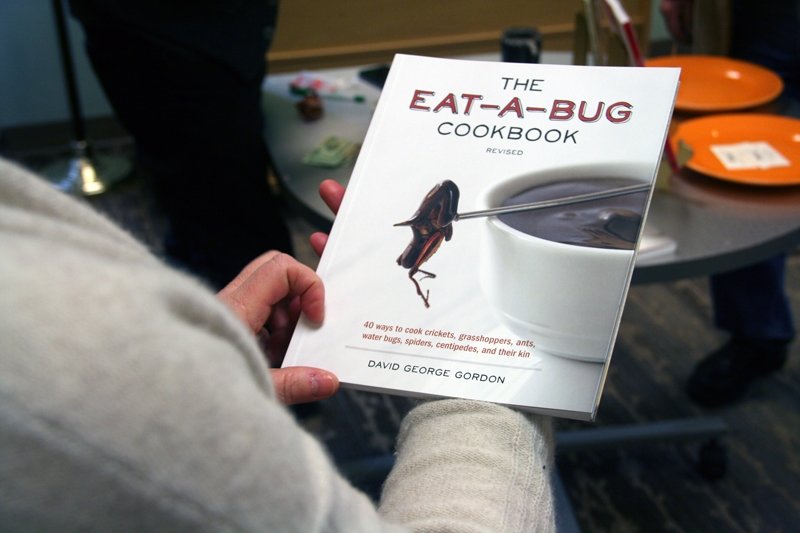 Key Center Librarian Rosina Vertz reads through author and presenter David George Gordon’s Eat-a-Bug Cookbook, a book filled with bug recipes. Photo by Anna Brones, KP News
Key Center Librarian Rosina Vertz reads through author and presenter David George Gordon’s Eat-a-Bug Cookbook, a book filled with bug recipes. Photo by Anna Brones, KP News
Most people would cringe at the thought of eating bugs for dinner, but David George Gordon does it for a living. Commonly referred to as “the godfather of insect cuisine” and the “bug chef,” Gordon is an advocate for incorporating bugs and insects into our diets, a topic he spoke about on Jan. 9, during a presentation at the Key Center Library.
While eating insects might seem out of the ordinary for us, we are part of the few cultures in the world who don’t. In fact, 80 percent of the world’s countries eat insects. Gordon has been working hard to change that.
An award-winning author, naturalist and speaker, Gordon is a proponent of entomophagy –– “the fancy word for bug eating” as he puts it –– since the release of his “Eat-a-Bug Cookbook” in 1998, and he has seen the cultural shift that has started to take place in regards to consuming insects.
A good source of protein, in the face of an ever threatened food system, many have advocated for insects as part of a more sustainable diet.
“Raising cattle is not a very sustainable thing,” said Gordon.
He said to produce one hamburger, for example, it takes around 460 gallons of water, not to mention the amount of land required to raise cattle. Today livestock production accounts for 70 percent of all agricultural land use. Given that global demand for livestock is estimated to more than double by 2050.
If we are going to meet that demand, he said that society is not only going to have to think creatively, but “going to have to think of culinary alternatives.” Insects are one of them.
“We’re not talking about acres and acres,” said Gordon in regards to what’s needed for insect production.
He says insect production can easily be done on a small and local scale.
He feels that one day, it’s not unreasonable to imagine “insect hubs,” regional productions of insects for local consumption. Not only do they require less land to raise, he said, but insects produce very little greenhouse gases in relation to livestock. Globally, livestock are responsible for 14.5 percent of all greenhouse gas emissions, and of that chunk, cattle are responsible for 65 percent of it, he said.
While there are many other bug lovers like Gordon in the world, consuming insects isn’t just happening on an individual level. The increasing need for creative solutions for our food system has encouraged many entrepreneurs to launch insect-focused start-ups, from World Entomophagy, who makes flour out of insects to Chapal, a company that produces “cricket bars,” healthy energy bars boosted with cricket protein powder, to Six Food who is responsible for “chirps,” tortilla chips made with cricket flour.
“The more you see them the more you might grab them as an experiment or a treat,” said Gig Harbor resident Marilyn Thompson, who attended the talk.
“Bugs in our food is still kind of a novelty,” said Gordon, pointing to a photo of a lollipop with a bug inside. Unfortunately that is because “we do have this really, really strong feeling that bugs are germy, gross and disgusting,” said Gordon.
He said that a cardboard container with fried worms generates a different filling than a container of French fries. “But look at an energy bar or a bag of chips made with cricket flour, however, and they don’t look any different from other snacks. That just might be the bridge that gets us to making insects a part of our regular diet,” he said.
After his presentation, Gordon served samples of a Chapul Cricket Bar. Adam Broderick, age 4, who was attending with his mother and younger sister walked straight up to the table and put a piece in his mouth. “It tastes like gingerbread” Adam said.
As Gordon put it, whether you are a child excited about a new and different snack, or an adult who is rethinking how you eat, “there is a bug in your future whether you know it or not.”
UNDERWRITTEN BY THE FUND FOR NONPROFIT NEWS (NEWSMATCH) AT THE MIAMI FOUNDATION, THE ANGEL GUILD, ADVERTISERS, DONORS AND PEOPLE WHO SUPPORT INDEPENDENT, NONPROFIT LOCAL NEWS